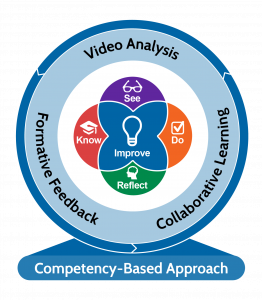EarlyEdU Approach
Guiding Frameworks
Two primary frameworks—the Competency-Based Educator Development Model (CEDM) and the Head Start Early Learning Outcomes Framework—serve as the bases for all EarlyEdU courses. They represent research-based approaches that make early education professionals more effective and set clear, age-appropriate expectations for child development.
Competency-Based Educator Development Model
 The Competency-Based Educator Development Model is centered around helping educators improve their practice.
The Competency-Based Educator Development Model is centered around helping educators improve their practice.
At its core is the Intentional Teaching Framework (Hamre, Downer, Jamil, & Pianta, 2012; Joseph & Brennan, 2013). First, instructors and participants identify what skills, attitudes, and dispositions they want to improve and how they will demonstrate that improvement. Then, they determine what learners need to know, see, do, and reflect on in order to achieve that improvement.
This competency-based approach is rooted in principles of adult learning and teaching. Video analysis, collaborative learning, and formative feedback are all used to activate the Intentional Teaching Framework.
Video analysis
EarlyEdU courses engage participants in observation and reflection on teaching practices through the use of video. Participants watch authentic examples of educators in the classroom. They also video record themselves during their own teaching, which provides a powerful opportunity to not only reflect on oneself, but also actively take part in the feedback process with the instructor and other course participants. Video observation and analysis serves as an influential tool for enacting the Intentional Teaching Framework.
Collaborative Learning
Communities of Reflection and Practice (CORP) help participants learn to give effective feedback. The process incorporates strength-based observations, a connection to the assignments and readings, and suggestions for improvement. It also provides social support by bringing together participants with similar career paths and interests. When participants engage together in authentic and useful conversations about their practice, they enact an important aspect of becoming a professional.
Formative Feedback
EarlyEdU course instructors are expected to provide frequent and productive feedback to participants. When participants video record themselves demonstrating the practices targeted in assignments, you assume the role of coach and provide specific feedback on the participants’ use of the practice and progress toward mastery. Feedback—shared either in-person or through video—is based on focused observation and occurs within a partnership between you and the participant that is centered around learning. By engaging in the feedback process with instructors, participants are supported in their own development and they also have a model for how to provide coach-quality feedback to their peers.
The CEDM is discussed in-depth in the EarlyEdU Approach course. Return to Module 1 in the course if you want to review this topic further.
Head Start Early Learning Outcomes Framework: Birth to Age Five
The Head Start Early Learning Outcomes Framework (HSELOF) is a comprehensive guide to learning and development throughout early childhood. It includes developmental goals and indicators related to approaches to learning; social and emotional development; language and literacy; cognition, and perceptual, motor, and physical development. The document breaks down targeted behaviors by age group and provides examples of what early learning professionals can look for to assess a child’s developmental progress. Many EarlyEdU courses use the framework as a guide and explore how specific teaching strategies promote growth across the framework’s domains. The framework and support materials are available on the Head Start Early Childhood Learning & Knowledge Center website.
Framework for Effective Practice
This framework represents four integral elements of quality teaching and learning: engaging every day interactions with children (the foundation); choosing and implementing a strong curriculum (the first pillar); using regular assessment of children’s skills (the second pillar), and individualized teaching (the roof). These elements, when connected with one another, form a single structure that fosters children’s learning and development.
Expand each section of the house to recap:
The Foundation: Engaging Interactions and Environments
Effective, engaging interactions and environments are the foundation for all learning in early childhood classrooms. High-quality preschool classrooms include a well-organized and well-managed classroom, social and emotional support, and instructional interactions and materials that stimulate children’s thinking and skills.
The First Pillar: Research-Based Curricula and Teaching Practices
A high-quality, research-based curriculum provides learning goals and activities in key areas of children’s development that support school readiness goals. A curriculum provides guidance on what to teach (content) and how to teach (learning experiences and teaching strategies). The content is drawn from current child development science, the interests and ideas of the children, and the values of the community.
The Second Pillar: Ongoing Child Assessment
Ongoing assessment is integral to curriculum and instruction. Our objective is to help children achieve school readiness and their individual learning goals. We need to keep track of how the children are doing. Assessment information helps us monitor progress—both for individual children and for the program as a whole. Assessment information needs to be valid, reliable, and useful, so the results can inform curriculum and instruction.
The Roof: Highly Individualized Teaching and Learning
Young children vary widely in their skills, knowledge, backgrounds, and abilities. Teaching must effectively reach all children, regardless of their abilities and disabilities. Effective instruction for all children requires specialized teaching and learning opportunities to access, participate, and thrive in the preschool classroom. Effective teachers are sensitive and skilled in interactions; they use ongoing formative assessment of each child’s skills to plan instruction; and they choose and use curricula and activities that engage all children, regardless of their strengths or needs.
